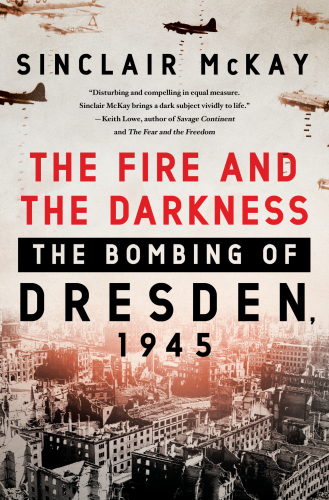
The Fire and the Darkness
The Bombing of Dresden, 1945
کتاب های مرتبط
- اطلاعات
- نقد و بررسی
- دیدگاه کاربران
نقد و بررسی

December 2, 2019
Historian McKay (The Secret Lives of Codebreakers) portrays Dresden before, during, and immediately after its February 1945 destruction by Allied bombers in this vivid and exhaustive narrative. McKay profiles Dresden residents, including Viktor Kemperer, a philology professor and Jewish convert to Christianity, and 15-year-old Winfried Bielss, a member of the Hitler Youth, and sketches the city’s favored status among British and American socialites, which locals hoped would keep them safe from attack. On the night of February 13, however, nearly 800 Royal Air Force bombers took off from England for Dresden; their objective, according to McKay, was to “create an atmosphere of panic” among the population, which included thousands of refugees fleeing the Red Army’s advance into northern Germany. The planes carried 4,000-pound “Blockbuster” bombs and incendiary devices intended to spark fires in the wreckage. Drawing from memoirs, letters, and diaries, McKay describes people huddling in cellars, many of which collapsed or became suffocating from heat, smoke, and lack of oxygen, and emerging to find burning corpses, melting roads, and an estimated mile-high conflagration in the city center. An estimated 25,000 people died in three waves of Allied attacks over two days. McKay’s extensive research and animated prose capture the terror and tragedy of the bombing. Readers won’t soon forget this devastating account.

December 15, 2019
A history of the 1945 bombing that made Dresden "a totem to the obscenity of total war." On the evening of Feb. 13, 1945, writes British literary critic McKay (The Scotland Yard Puzzle Book, 2019, etc.), British bombers unleashed a savage attack on the Nazi-controlled city of Dresden, killing some 25,000 people and turning the "Florence on the Elbe," as the elegant cultural center was known, into "a burnt and bloody wilderness." The bombing was the focus of Kurt Vonnegut's Slaughterhouse-Five, based on his experiences during the historic firestorm as a prisoner of war. After describing life in Dresden before the bombing, McKay re-creates the nighttime attack in the words of residents as well as German officials, Allied commanders and bomb crews, and many others. "No one could ever imagine that our city would be the victim of a cruel and senseless bombing," says Gisela Reichelt, who was 10 at the time. Hers was among many eyewitness accounts McKay examined in the city's archives. Like others, she dismissed the nighttime air-raid alarms--they had always proven false--that preceded the dropping of nearly 4,000 tons of high-explosive bombs and incendiary devices. Payloads from hundreds of planes set the city on fire, tore buildings apart, and dismembered people in shelters. With good weather and few Nazi defenses, young airmen pursuing "just another target" found Dresden was "theirs to incinerate." McKay's harrowing narrative conjures the "satanic music" of passing aircraft and the burning of corpses whose stench was still recalled years later, all set against the daily malevolence of life under the Gestapo. Many immediately questioned the morality of bombing a city of limited strategic importance (it was a rail transport hub). American planes engaged in subsequent Dresden raids. The city, including its baroque churches and concert halls, has since been restored. A full and powerful account of warfare that ignored the distinction between military and civilian objectives.
COPYRIGHT(2019) Kirkus Reviews, ALL RIGHTS RESERVED.

Starred review from January 1, 2020
February 2020 marks the 75th anniversary of the fire-bombing of Dresden, one of the most controversial Allied actions of World War II. Lasting two days, the bombing killed an estimated 25,000 to 35,000 civilians, many of who were fleeing the onslaught of the Soviet Army. MacKay's (The Secret Lives of Codebreakers) engrossing account of Dresden's citizens, in the moments before, during, and after the bombings, describe a community trying to manage everyday life in Nazi Germany until a cataclysm interrupted its routine. Included are personal narratives describing the stories of Allied prisoners of war, the accounts of the few remaining Jews, and the experiences of British and American air crews. Most of these crew members had not flown so far over enemy territory; for them, it was another risky mission and extremely fear-filled flight. VERDICT Well researched, powerfully written, and balanced, this book will let the reader decide whether the bombing of Dresden was a war crime or a calculated step to bring a long and bloody war to an end. For all interested in military history and World War II.--Beth Dalton, Littleton, CO
Copyright 2020 Library Journal, LLC Used with permission.

























دیدگاه کاربران